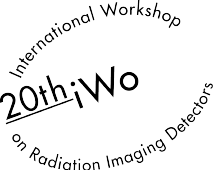Speaker
Description
ABSTRACT
In the last decade, different Positron Emission Tomography (PET) crystals have been proposed for brain PET detectors [1]. Brain PET cameras with restricted field of view (FOV) to a smaller size to cover the brain can both exhibit much higher performance and lower the cost when comparing to conventional whole-body PET scanners. All the present designs based on scintillating crystals employ most commonly known materials such as Sodium Iodide (NaI), Lutetium Yttrium Orthosilicate (LYSO), Bismuth Germanate Oxide (BGO) etc. This is due to their relatively good parameters such as light yield, density, and especially low cost comparing to solid-state crystals. The only drawback of using scintillation crystals is having a modest energy resolution. Besides, crystal based detectors have intrinsic uncertainty because of the depth of interaction (DOI) which is not accurate due to thick scintillation materials. This uncertainty causes parallax error which is a major problem in PET.
In this study, both conventional crystals used in commercialized scanners and the recently proposed scintillation crystals with promising physical properties were analyzed. In total, 13 crystals were simulated using Geant4 Application for Tomographic Emission [2] (GATE) toolkit and the performance in terms of sensitivity of each of the crystals was evaluated according to NEMA standards [3]. New scintillation crystals were added to the GATE material database.
The performance evaluation results showed that Hafnium dioxide (HfO2) is a very promising material with an outstanding sensitivity when compared to the remaining crystals and followed by BGO which is the most common type of crystal in use. Lutetium Fine Silicate (LFS), a newly proposed crystal also shows the potentials of being a promising detector material for PET imaging, while Lutetium Aluminum Perovskite (LuAP), Lutetium Oxyortho-Silicate (LSO) and Lutetium Gadolinium Oxyortho-Silicate (LGSO) crystals show high sensitivity which categorizes them among the mostly used materials for medical imaging. Those crystals whose sensitivities are low, Cesium Hafnium Chloride (CHC), Strontium Iodide (SrI2), and Cs2LiLaBr6:Ce (CLLB) can be considered for either high spatial resolution or very fast cameras.
Keywords: PET, scintillation crystals, GATE simulation, sensitivity, HfO2, LFS
REFERENCES
1. Paul Lecoq, "Development of new scintillators for medical applications", Nuclear Instruments and Methods in Physics Research Section A: Accelerators, Spectrometers, Detectors and Associated Equipment, 809, 130-139, 2016.
2. Jan, S. et al., "GATE: A simulation toolkit for PET and SPECT", Physics in Medicine and Biology, 49, 4543-4561, 2004.
3. NEMA NU-4 2008 Standards Publication, "Performance Measurements of Small Animal Positron Emission Tomographs", Rosslyn, VA: National Electrical Manufacturers Association, 2008.
